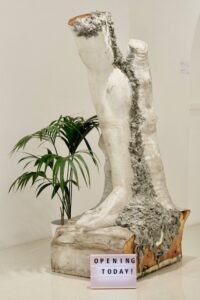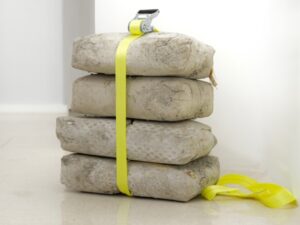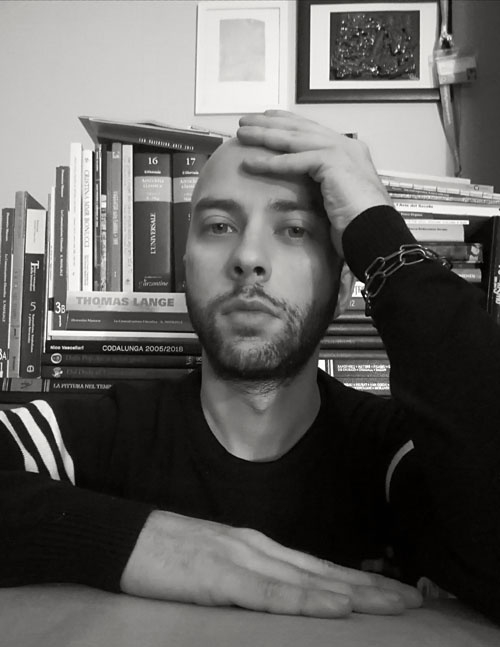L’impresa e l’Opera is the title of the exhibition by the five artists members of Ombrelloni Art Space; artist-run space of the Roman art scene. The exhibition, curated by Alice Falsaperla and hosted at the historical La Nuvola Gallery in Margutta street, starting from a cinematographic reference, links the research of the artists involved, establishing a coherent relationship between plurality, unity and difference. Thanks to the words of the curator, let’s enter into the features concerning the project.

A.A.V.V., L’Impresa e l’Opera, installation view at Galleria La Nuvola, Roma, photo Domenico Flora, courtesy Galleria La Nuvola
Davide Silvioli: How did your relationship with Ombrelloni Art Space and your interest in the work of the artists who make up this artist-run space come about?
Alice Falsaperla: My collaboration with Ombrelloni Art Space was born in 2020, on the occasion of the opening of the Learn To Fly exhibition at the Moma – Museo Abitabile in Rome. There I met the artist Alessandro Calizza, who a few months before had moved his studio to Via dei Lucani in San Lorenzo, the current headquarter of Ombrelloni Art Space. Following this meeting, intrigued by the author’s research, I visited his workplace and we’ve immediately established a collaboration. On that occasion I visually came into contact with the creations of the other artists who were beginning to inhabit the studio, such as Krizia Galfo and Cristallo Odescalchi. I was immediately struck by Krizia’s freezing colors and by Cristallo’s “binary” synthesis. I immediately felt a particular fervor to distinguish this environment which prompted me, not only to dedicate studies and articles to it, but also to follow its expansion but also to follow its expansion by bringing the poetics of Matteo Peretti and Greg Jager, together with others, to the Galleria La Nuvola.

Krizia Galfo, The hole, 2023, oil on canvas, D 40 cm, photo Domenico Flora, courtesy Galleria La Nuvola
What does the title of the exhibition refer to and on what basis does the thought, therefore the theme, which substantiates the project arise?
The title L’impresa e l’Opera alludes to a double meaning, placed both at the basis of the exhibition and of Werner Herzog’s film-masterpiece, Fitzcarraldo (1982). “The enterprise” suggests the icarist action that the protagonist performs to fulfill a dream, about building an opera house in the Amazonforest. The choice of the term indicates the duality of an event that could lead to good and evil, to achievement and failure. “The Opera”, on one hand, alludes to the desiring element, the Opera House, and on the other hand of the artistic creation, to the constitutive element of the exhibition. I devised this concept by almost “synaptically” associating the main themes of the film, such as the surreal and ideal, mythical and social, ironic and dramatic elements, with the different productions of the authors, proposing current points of contact and providing them with a challenge that did not distort any stylistic figure, but as an investigation tool for new formulas and techniques.

Alessandro Calizza, Brand New Ruins, 2023, tmixed media, 100 x 80 x 190 cm, photo Domenico Flora, courtesy Galleria La Nuvola
How, then, do the works individually argue for the contents of the exhibition?
The exhibition opens with the works by Krizia Galfo, who turns a theme into a structure. These are “revealing glimpses” that take the form of circular oil canvases. They could be associated with the portholes of a boat, the meanings through which the protagonist’s intent moves. One manifests the epiphanic moment of a face about to turn; in another one there is the centrifugal gesture of standing about to roll, as a reference to the sphericity of the boulder, the ideal that Sisyphus is forced to support in the myth that takes his name. On the basis of the latter, Greg Jager continues a reflection in another form. Four irregular bags of cement, tied to a fluorescent belt, overturn the concept of absolute and containment. The artist refers to the distinction between “space” and “place”, which the philosopher Timothy Morton defines as an attempt of “colonization” by the first on the second. The concrete refers to the concept of space and, therefore, to the attempt to dominate what is uncontaminated. Photography, on the other hand, alludes to the place, to the inhospitable nature that is defined beyond human control.

Cristallo Odescalchi, Senza titolo, 2023, acrylic on wooden board, 257 x 126 cm, photo Domenico Flora, courtesy Galleria La Nuvola
Jager’s alarming chromaticism returns in Alessandro Calizza’s creation on paper, through an unjustified mathematical grid. The protagonist is vanitas, active contemplation of the transience of life, exemplified by Mozart’s skull, as a bizarre “flower vase” and reference to music. It is a key to understand colonialism, personified in the film by Fitzcarraldo, which continues in the exhibition with the cast of Michelangelo’s David’s Leg. A gray substance emerges from it, which symbolically stands for procrastination and renunciation. It is a violent appropriation of the monument, which warns of the fixity of canons and which traces the constructive value in the ruin. An organic vision is fully achieved by Matteo Peretti’s sound installation, created in collaboration with the composer Alessandro Angiolillo: a strip of living meadow as a border to be crossed or trampled upon becomes a dilemma that historically concerns man. Finally, Cristallo Odescalchi through spatial experimentation, sees an integration between the natural forms represented and the architecture of the Gallery. The subject is the carving of a heel on a white wooden table; it coincides with the “negative” which holds back the passage of a step, that of the colonist towards an unexplored terrain. In the center, an empty space that separates the foot from the ground, as a synthesis of Fitzcarraldo’s enterprise, of the human towards the unknown.

Greg Jager, Space, 2023, concrete and polyester straps for anchoring, 50 x 35 x 55 cm, photo Domenico Flora, courtesy Galleria La Nuvola
Starting from this vision, how does the installation narrate the exhibition?
The installation that I’ve curated tells the exhibition through twelve works created ad hoc by the artists, which starts from the representation of the human figure up to the total abstraction of form and color. Within these two extreme parentheses, the point of view of all the authors emerges towards the film and the topics that concern to it. A dialogue is established between each creation on display, from an iconographic to a conceptual point of view.

Matteo Peretti, La realtà dei sogni, 2023, lawn, sensors and sound system, created by the composer Alessandro Angiolillo, photo Domenico Flora, courtesy Galleria La Nuvola
Finally, from a curatorial point of view, do you feel more that the exhibition corresponds to a group show by five artists or to a solo show by Ombrelloni?
According to a curatorial aspect, I answer that the exhibition corresponds to a solo show by Ombrelloni. I look at it as an artistic agglomeration, subject to an osmotic contamination, dictated by the attendance by the artists which share the same Studio, while maintaining their own identity characteristics. This denotation allows the Space to determine itself not only on a national level, but also on an international level too and to innovate on a historical and contemporary level.
Info:
A.A. V.V. L’impresa e l’Opera
curated by Alice Falsaperla
14/04/2023– 5/05/2023
An exhibition by Ombrelloni Art Space
Galleria La Nuvola
Via Margutta, 41 Roma
www.gallerialanuvola.it

Contemporary art critic and curator, he has curated exhibitions in galleries, independent and institutional spaces. He has lectured in Italy and abroad. His texts and research are published in catalogs, sector magazines, gallery editions and monographs. He is the curator of artist archives, contributor to specialized magazines and press offices. He collaborates with foundations, public museums, publishing houses and universities on research and curatorial projects.






NO COMMENT